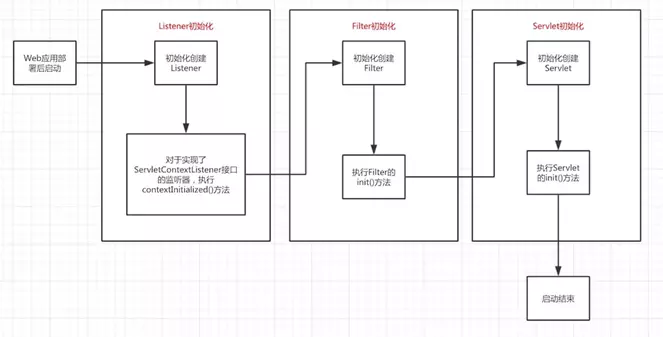Spring容器启动源码分析
1. 前言
最近搭建的工程都是基于SpringBoot,简化配置的感觉真爽。但有个以前的项目还是用SpringMvc写的,看到满满的配置xml文件,却有一种想去深入了解的冲动。折腾了好几天,决心去写这篇关于Spring启动的博客,自己是个刚入职的小白,技术水平有限,也是硬着头皮看源码去Debug,很多不懂的地方还请谅解!
2. 概述
先给出几个让我头皮发麻的概念:web容器,Spring容器,SpringMvc容器
容器就是管理对象的地方,例如web容器就是管理servlet的地方,Spring容器就是管理Service,dao等Bean的地方,SpringMvc就是管理Controller等bean的地方(下文会做解释)。一个SpringMvc项目的启动离不开上述三个容器。所以这就是这篇文章的讲点,各个容器的启动过程解析。
3. Web容器初始化过程
官方文档是对于Web容器初始化时是这样描述的(英文不懂,已翻译成中文)
1. 部署描述文件(web.xml)中的<listener>标记的监听器会被创建和初始化
2. 对于实现了ServletContextListener的监听器,会执行它的初始化方法 contextInitialized()
3. 部署描述文件中的<filter>标记的过滤器会被创建和初始化,调用其init()方法
4. 部署描述文件中的<servlet>标记的servlet会根据<load-on-startup>中的序号创建和初始化,调用init()方法

大致流程了解之后,结合自己的SpringMvc项目一步步深入,先贴一下基本的web.xml文件

<?xml version="1.0" encoding="UTF-8"?>
<web-app xmlns:xsi="http://www.w3.org/2001/XMLSchema-instance" xmlns:web="http://java.sun.com/xml/ns/javaee" xmlns="http://java.sun.com/xml/ns/javaee" xsi:schemaLocation="http://java.sun.com/xml/ns/javaee http://java.sun.com/xml/ns/javaee/web-app_2_5.xsd" id="WebApp_ID" version="2.5">
<display-name>dmpserver</display-name>
<welcome-file-list>
<welcome-file>login.jsp</welcome-file>
</welcome-file-list>
<context-param>
<param-name>contextConfigLocation</param-name>
<param-value>classpath:spring.xml</param-value>
</context-param>
<context-param>
<param-name>log4jConfigLocation</param-name>
<param-value>classpath:log4jConfig.xml</param-value>
</context-param>
<filter>
<filter-name>encodingFilter</filter-name>
<filter-class>org.springframework.web.filter.CharacterEncodingFilter</filter-class>
<init-param>
<param-name>encoding</param-name>
<param-value>utf-8</param-value>
</init-param>
</filter>
<filter-mapping>
<filter-name>encodingFilter</filter-name>
<url-pattern>/*</url-pattern>
</filter-mapping>
<listener>
<listener-class>org.springframework.web.context.ContextLoaderListener</listener-class>
</listener>
<listener>
<listener-class>org.springframework.web.util.Log4jConfigListener</listener-class>
</listener>
<servlet>
<description>spring mvc servlet</description>
<servlet-name>rest</servlet-name>
<servlet-class>org.springframework.web.servlet.DispatcherServlet</servlet-class>
<init-param>
<param-name>contextConfigLocation</param-name>
<param-value>
classpath:spring-mvc.xml
</param-value>
</init-param>
<load-on-startup>1</load-on-startup>
</servlet>
</web-app>

1. 容器会先解析<context-param>中的键值对(上述代码重点关注Spring配置文件Spring.xml)
2. 容器创建一个application内置对象servletContext(可以理解为servlet上下文或web容器),用于全局变量共享
3. 将解析的<context-param>键值对存放在application即servletContext中
4. 读取<listener>中的监听器,一般会使用ContextLoaderListener类,调用其contextInitialized方法,创建IOC容器(Spring容器)webApplicationContext。将webApplication容器放入application(servlet上下文)中作为根IOC容器,键名为WebApplicationContext.ROOT_WEB_APPLICATION_CONTEXT_ATTRIBUTE 注意的是,webApplicationContext是全局唯一的,一个web应用只能有一个根IOC容器。因为这个根IOC容器是读取<context-param>配置的键值对来创建Bean,这个根IOC容器只能访问spring.xml中配置的Bean,我们在Spring.xml中一般配置的是service,dao等Bean。所以根IOC容器(Spring容器)只能管理service,dao等Bean
5. listener加载完毕后,加载filter过滤器
6. 加载servlet,一般springMvc项目中会优先加载 DispatcherServlet(现在开始加载SpringMvc容器了)
7. DispatcherServlet的父类FrameworkServlet重写了其父类的initServletBean()方法,在初始化时调用initWebApplicationContext()方法和onRefresh()方法
8. initWebApplicationContext()方法会在servletContext(即当前servlet上下文)创建一个子IOC容器(即SpringMvc容器),如果存在上述的根IOC容器,就设置根IOC容器作为父容器,如果不存在,就将父容器设置为NULL
9. 读取<servlet>标签的<init-param>配置的xml文件并加载相关Bean。此时加载的是Spring-mvc.xml配置文件,管理的是Controller等Bean
10. onRefresh()加载其他组件
4. 启动过程分析
4.1 listener初始化Spring容器
tomcat启动后,<context-param>标签的内容读取后会被放进application中,做为Web应用的全局变量使用,接下来创建listener时会使用到这个全局变量,因此,Web应用在容器中部署后,进行初始化时会先读取这个全局变量,之后再进行上述讲解的初始化启动过程。
查看ContextLoaderListener源码

public class ContextLoaderListener extends ContextLoader implements ServletContextListener {
public ContextLoaderListener() {
}
public ContextLoaderListener(WebApplicationContext context) {
super(context);
}
public void contextInitialized(ServletContextEvent event) {
this.initWebApplicationContext(event.getServletContext());
}
public void contextDestroyed(ServletContextEvent event) {
this.closeWebApplicationContext(event.getServletContext());
ContextCleanupListener.cleanupAttributes(event.getServletContext());
}
}

据官方文档说明,实现ServletContextListener接口,执行contextInitialized(),进入initWebApplicationContext方法。contextInitialized()和contextDestroyed()方法会在web容器启动或销毁时执行。网上查了下此处设计模式用到的是观察者模式和代理模式,自己也不懂就不做详解了
查看ContextLoader.class中的initWebApplicationContext方法

public WebApplicationContext initWebApplicationContext(ServletContext servletContext) {
/*
首先通过WebApplicationContext.ROOT_WEB_APPLICATION_CONTEXT_ATTRIBUTE
这个String类型的静态变量获取一个根IoC容器,根IoC容器作为全局变量
存储在application对象中,如果存在则有且只能有一个
如果在初始化根WebApplicationContext即根IoC容器时发现已经存在
则直接抛出异常,因此web.xml中只允许存在一个ContextLoader类或其子类的对象
*/
if (servletContext.getAttribute(WebApplicationContext.ROOT_WEB_APPLICATION_CONTEXT_ATTRIBUTE) != null) {
throw new IllegalStateException("Cannot initialize context because there is already a root application context present - check whether you have multiple ContextLoader* definitions in your web.xml!");
} else {
Log logger = LogFactory.getLog(ContextLoader.class);
servletContext.log("Initializing Spring root WebApplicationContext");
if (logger.isInfoEnabled()) {
logger.info("Root WebApplicationContext: initialization started");
}
long startTime = System.currentTimeMillis();
try {
if (this.context == null) {
// 创建一个根IOC容器
this.context = this.createWebApplicationContext(servletContext);
}
if (this.context instanceof ConfigurableWebApplicationContext) {
ConfigurableWebApplicationContext cwac = (ConfigurableWebApplicationContext)this.context;
if (!cwac.isActive()) {
if (cwac.getParent() == null) {
// 为根IOC容器设置一个父容器
ApplicationContext parent = this.loadParentContext(servletContext);
cwac.setParent(parent);
}
this.configureAndRefreshWebApplicationContext(cwac, servletContext);
}
}
//将创建好的IoC容器放入到application对象中,并设置key为WebApplicationContext.ROOT_WEB_APPLICATION_CONTEXT_ATTRIBUTE
servletContext.setAttribute(WebApplicationContext.ROOT_WEB_APPLICATION_CONTEXT_ATTRIBUTE, this.context);
ClassLoader ccl = Thread.currentThread().getContextClassLoader();
if (ccl == ContextLoader.class.getClassLoader()) {
currentContext = this.context;
} else if (ccl != null) {
currentContextPerThread.put(ccl, this.context);
}
if (logger.isDebugEnabled()) {
logger.debug("Published root WebApplicationContext as ServletContext attribute with name [" + WebApplicationContext.ROOT_WEB_APPLICATION_CONTEXT_ATTRIBUTE + "]");
}
if (logger.isInfoEnabled()) {
long elapsedTime = System.currentTimeMillis() - startTime;
logger.info("Root WebApplicationContext: initialization completed in " + elapsedTime + " ms");
}
return this.context;
} catch (RuntimeException var8) {
logger.error("Context initialization failed", var8);
servletContext.setAttribute(WebApplicationContext.ROOT_WEB_APPLICATION_CONTEXT_ATTRIBUTE, var8);
throw var8;
} catch (Error var9) {
logger.error("Context initialization failed", var9);
servletContext.setAttribute(WebApplicationContext.ROOT_WEB_APPLICATION_CONTEXT_ATTRIBUTE, var9);
throw var9;
}
}
}

initWebApplicationContext方法的主要目的是创建一个根IOC容器,并放入servlet上下文中。看上述源码可知,根IOC容器只能仅有一个,作为全局变量存储在servletContext中。将根IoC容器放入到application对象之前进行了IoC容器的配置和刷新操作,调用了configureAndRefreshWebApplicationContext()方法,该方法源码如下:

protected void configureAndRefreshWebApplicationContext(ConfigurableWebApplicationContext wac, ServletContext sc) {
String configLocationParam;
if (ObjectUtils.identityToString(wac).equals(wac.getId())) {
configLocationParam = sc.getInitParameter("contextId");
if (configLocationParam != null) {
wac.setId(configLocationParam);
} else {
wac.setId(ConfigurableWebApplicationContext.APPLICATION_CONTEXT_ID_PREFIX + ObjectUtils.getDisplayString(sc.getContextPath()));
}
}
wac.setServletContext(sc);
/*
在容器启动时,会把<context-param>中的内容放入servlet上下文的全局变量中,
此时获取key为contextConfigLocation的变量,及Spring.xml配置文件
将其放入到webApplicationContext中
*/
configLocationParam = sc.getInitParameter("contextConfigLocation");
if (configLocationParam != null) {
wac.setConfigLocation(configLocationParam);
}
ConfigurableEnvironment env = wac.getEnvironment();
if (env instanceof ConfigurableWebEnvironment) {
((ConfigurableWebEnvironment)env).initPropertySources(sc, (ServletConfig)null);
}
this.customizeContext(sc, wac);
wac.refresh();
}

configureAndRefreshWebApplicationContext方法比较重要的是把配置文件信息放入根IOC容器中。方法最后调用了refresh()方法,对配置文件信息(Bean)进行加载。因为refresh()这是个ConfigurableApplication-Context接口方法,想到了它的常用实现类ClassPathXmlApplicationContext,一层层进去找到了Abstract-ApplicationContext,实现了refresh(),见如下源码:

public void refresh() throws BeansException, IllegalStateException {
Object var1 = this.startupShutdownMonitor;
synchronized(this.startupShutdownMonitor) {
this.prepareRefresh();
ConfigurableListableBeanFactory beanFactory = this.obtainFreshBeanFactory();
this.prepareBeanFactory(beanFactory);
try {
this.postProcessBeanFactory(beanFactory);
this.invokeBeanFactoryPostProcessors(beanFactory);
this.registerBeanPostProcessors(beanFactory);
this.initMessageSource();
this.initApplicationEventMulticaster();
this.onRefresh();
this.registerListeners();
this.finishBeanFactoryInitialization(beanFactory);
this.finishRefresh();
} catch (BeansException var9) {
if (this.logger.isWarnEnabled()) {
this.logger.warn("Exception encountered during context initialization - cancelling refresh attempt: " + var9);
}
this.destroyBeans();
this.cancelRefresh(var9);
throw var9;
} finally {
this.resetCommonCaches();
}
}
}

该方法主要用于创建并初始化contextConfigLocation类配置的xml文件中的Bean,因此,如果我们在配置Bean时出错,在Web应用启动时就会抛出异常,而不是等到运行时才抛出异常。因为技术能力有限加上此处方法太多,就不在一一解析了。到此为止,整个Spring容器加载完毕,下面开始加载SpringMVC容器
4.2 Filter初始化
因为Filter的操作没有涉及IOC容器,此处不做详解,上面web.xml中配置的是一个UTF8编码过滤器
5. 总结
时间有限,只大致介绍了Spring容器的初始化,后面还没来得及整理,对于springMvc容器的创建和初始化下篇文章见
Spring容器启动源码分析的更多相关文章
- 深入理解 spring 容器,源码分析加载过程
Spring框架提供了构建Web应用程序的全功能MVC模块,叫Spring MVC,通过Spring Core+Spring MVC即可搭建一套稳定的Java Web项目.本文通过Spring MVC ...
- Spring容器启动源码解析
1. 前言 最近搭建的工程都是基于SpringBoot,简化配置的感觉真爽.但有个以前的项目还是用SpringMvc写的,看到满满的配置xml文件,却有一种想去深入了解的冲动.折腾了好几天,决心去写这 ...
- 十、Spring之BeanFactory源码分析(二)
Spring之BeanFactory源码分析(二) 前言 在前面我们简单的分析了BeanFactory的结构,ListableBeanFactory,HierarchicalBeanFactory,A ...
- 九、Spring之BeanFactory源码分析(一)
Spring之BeanFactory源码分析(一) 注意:该随笔内容完全引自https://blog.csdn.net/u014634338/article/details/82865644,写的 ...
- Spring Developer Tools 源码分析:二、类路径监控
在 Spring Developer Tools 源码分析一中介绍了 devtools 提供的文件监控实现,在第二部分中,我们将会使用第一部分提供的目录监控功能,实现对开发环境中 classpath ...
- Spring Developer Tools 源码分析:三、重启自动配置'
接上文 Spring Developer Tools 源码分析:二.类路径监控,接下来看看前面提到的这些类是如何配置,如何启动的. spring-boot-devtools 使用了 Spring Bo ...
- RocketMQ中Broker的启动源码分析(一)
在RocketMQ中,使用BrokerStartup作为启动类,相较于NameServer的启动,Broker作为RocketMQ的核心可复杂得多 [RocketMQ中NameServer的启动源码分 ...
- RocketMQ中Broker的启动源码分析(二)
接着上一篇博客 [RocketMQ中Broker的启动源码分析(一)] 在完成准备工作后,调用start方法: public static BrokerController start(Broker ...
- RocketMQ中PullConsumer的启动源码分析
通过DefaultMQPullConsumer作为默认实现,这里的启动过程和Producer很相似,但相比复杂一些 [RocketMQ中Producer的启动源码分析] DefaultMQPullCo ...
随机推荐
- 504错误解决办法 让你的浏览器强制在后端服务器执行而不用通过前端CDN服务器
因为后端执行时间过长,前端不等待,导致提示504错误的解决办法 504 错误是因为你的CDN服务器设置的延时有限, 超时导致的504 是前端不等待中止,是前端不行,后端应该正常 502 错误是后端 ...
- 解决 Jenkins 乱码以及命令不存在的问题
方法一: Jenkins----系统管理----系统设置----全局属性----勾选环境变量 键 LANG 值 zh_CN.UTF-8 方法二(如果脚本用的是python): PYTHONIOENCO ...
- Java Arrays.asList注意事项
https://blog.csdn.net/kusedexingfu/article/details/77824189
- CSS3动画实现高亮光弧效果,文字和图片(一闪而过)
前言 好久没有写博客啦,高亮文字和图片一闪而过的特效,用CSS3来写 先看文字吧, 就上代码了 .shadow { /* 背景颜色线性渐变 */ /* 老式写法 */ /* linear为线性渐变,也 ...
- Coding 账户与 本地 Git 客户端的配置
1.先创建cooding账户 ,注册地址:https://coding.net/ 2.创建好账户后登陆,在个人设置中 验证邮箱 和 验证手机 (邮箱很重要配置需要用到) 3.安装git 客户端 (在 ...
- java正则表达式验证邮箱、手机号码
/** * 验证邮箱地址是否正确 * @param email * @return */ public static boolean checkEmail(String email){ boolean ...
- Resttemplate请求失败如何获取返回的json
参考:https://blog.csdn.net/u011974797/article/details/82424004 https://www.cnblogs.com/liumz0323/p/106 ...
- java文件断点续传上传下载解决方案
这里只写后端的代码,基本的思想就是,前端将文件分片,然后每次访问上传接口的时候,向后端传入参数:当前为第几块文件,和分片总数 下面直接贴代码吧,一些难懂的我大部分都加上注释了: 上传文件实体类: 看得 ...
- CF G. Indie Album AC自动机+fail树+线段树
这个套路挺有意思的. 把 $trie$ 和 $fail$ 树都建出来,然后一起跑一跑就好了~ #include <queue> #include <cstdio> #inclu ...
- AtCoder4351 Median of Medians 二分, 树状数组
题目大意 定义一个从小到大的数列的中位数为第 $ \frac{n}{2}+1 $ 项.求一个序列的所有连续子序列的中位数的中位数. $ (n \leqslant 100000)$ 问题分析 由于\(n ...
